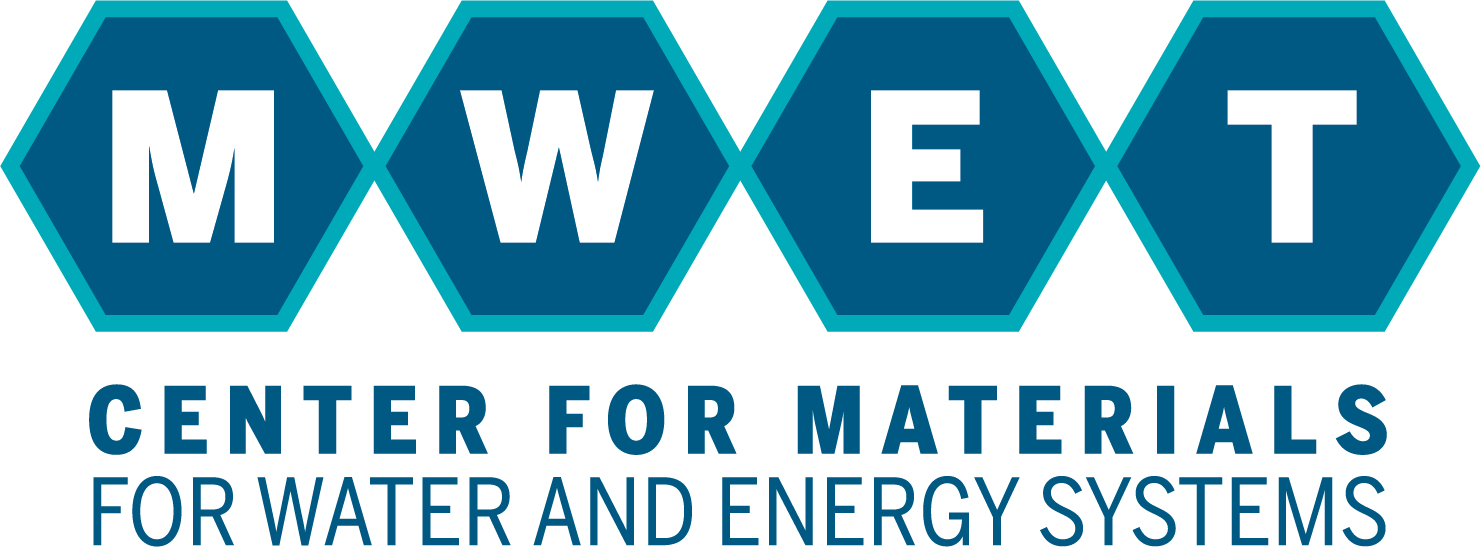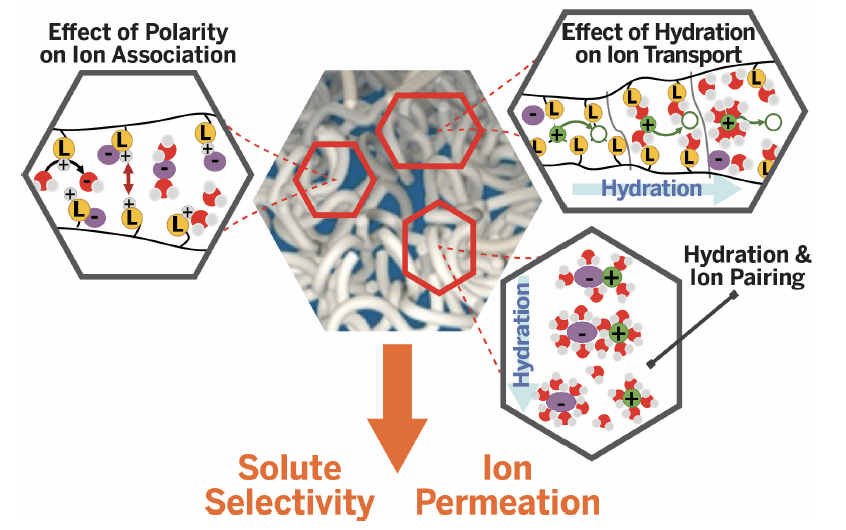
Fig. 3.1. GAP B will unravel the impact of hydration on ion transport spanning dry to wet systems, including ion pairing/association in hydrated polymer systems.
Role of Hydration in Ion Transport and Separations
Co-Leaders:
UT Austin: Benny Freeman
UC Santa Barbara: Rachel Segalman
Co-Investigators:
UT Austin: Lynn Katz, Venkat Ganesan, Graeme Henkelman
UC Santa Barbara: Chris Bates, Raphaële Clément
Problem Statement
Ion transport is central to both hydrated polymers for water filtration and dry polymers for electrochemical applications such as batteries. While remarkable progress has been made in the development of polymeric battery electrolytes and hydrated membranes for both desalination and energy applications (e.g., fuel cells, electrolyzers, and solar fuel generators), further progress hinges on developing fundamental insights into mechanisms of ion solvation/solubility and diffusion that are the foundations of ion permeability and ionic conductivity. As shown in Fig. 3.1 (above), developing this insight requires bridging understanding among both dry and hydrated membranes. Based on our success in developing ion selective membranes, we will create new design paradigms for ionic separations and develop an improved understanding of the role of hydration in the physics of ion transport. Furthermore, many membranes (e.g., RO membranes) bear charged groups, such as carboxylic acids and amines, in confined, low water content environments, where much less fundamental information is known, relative to aqueous solutions. The dissociation of these charged functional groups determines charge density in the RO membranes and, in turn, Donnan exclusion and, therefore, impacts ion rejection (i.e., selectivity) of such membranes. The impact of ionic strength, background solution complexity (e.g., mixtures of solutes and ions) on protonation/deprotonation, complexation, and ion pairing have been well studied in aqueous solution. In contrast, our knowledge of such interactions among solutes and solute/polymer functional groups within polymers is still lacking. The importance of continuum level parameters (e.g., ionic strength and dielectric constant) on these interactions has been identified in numerous studies, but robust models for predicting the influence of these parameters on membrane permeation and separation properties have not been fully developed for highly complex source waters. We will construct functionalized UMCP materials to understand the role of functional-group solute-solution interactions on continuum properties (e.g., ionic conductivity, water sorption, dielectric constant) in both confined and unconfined geometries. Whereas GAP A will provide insights into surface chemistry effects on ion solvation, dynamics, and affinity at surfaces at the molecular level, GAP B will focus on the role of hydration in bulk ion transport and separation, translating the molecular picture of GAP A to macroscopic membrane performance.
Molecular-scale permeation of water and solutes through dense, nonporous polymers controls separation properties of reverse osmosis (RO) and electrodialysis (ED) water purification membranes. Such membranes are invariably hydrated, with hydration varying over a wide range, from as low as 5 vol.% in RO membranes to 50 vol.% or more in some ion exchange membranes (IEMs) used for ED. Water and solute permeability vary by orders of magnitude with polymer water uptake (Fig. 3.2). Polymer membranes for energy applications (e.g., batteries, fuel cells, electrolyzers, and solar-fuel cells) are often chemically similar to IEMs used in water purification membranes. However, these membranes are either rigorously dry (in the case of solid polymer electrolytes (SPEs) for batteries) or much less hydrated (membranes for fuel cells, electrolyzers, and solar-fuel cells) than those used as water purification membranes. Solute transport (e.g., ion diffusion) is critical in both classes of membranes. While significant progress has been made in developing the membranes listed above, further progress hinges on a deep understanding of the fundamental origins of permeability and selectivity and how the presence of water modulates these properties. Indeed, the curation and analysis of a database of published polymer Li+- electrolyte conductivity performance (conductivity and selectivity) suggests that, with the exception of activation energy for conductivity, individual features commonly explored by this community are poor predictors of performance. Further, the performance of conventional lithium-ion batteries is limited by low selectivity of the metal cation relative to its counterion (where selectivity is parameterized by the transference number, t+). Indeed, SPE performance appears to be subject to an upper bound in permeability/selectivity similar to that which has stymied the development of seemingly unrelated gas and water separation membranes.
Further, solute size, polarity, and solvation radii are critically important for determining solute diffusion coefficients in aqueous solutions and membranes. For ions, however, their extent of hydration depends on the water content and dielectric properties of their environment, which can change enormously as membrane water content varies from dry (e.g., dielectric constant of 5-10) to highly hydrated environments that have dielectric constants closer to that of water (e.g., 40-50). Additionally, ion association (i.e., ion pairing) is favored in dehydrated, low dielectric media and disfavored in highly hydrated media. Ion association impacts effective ion size and charge, which can markedly affect ion transport rates in response to concentration gradients (e.g., RO) and electric fields (e.g., ED). Determination of individual ion diffusion coefficients from ion permeability and ionic conductivity measurements relies on the validity of the Nernst-Planck relation and on knowledge of ion association, both of which are poorly understood in hydrated membranes for water purification. Similarly, recent rigorous calculations of transference numbers for dry SPEs are substantially lower than those approximated from ideal solutions (Nernst-Einstein), presumably due to the formation of neutral ion clusters and charged ion triplets. Indeed, such phenomena have led to reports of seemingly non-physical negative transference numbers largely driven by the presence of negatively charged [anion-cation-anion]-ion triplets.
GAP B assembles a team with diverse expertise to bridge our understanding of wet (Freeman) and dry (Segalman, Clément) water-energy membranes with the goal of presenting design paradigms for future membranes. These design rules will be rooted in a fundamental understanding of the role of hydration on solute transport (e.g., water, ions, neutral molecules) in such membranes. We seek to cross-pollinate theory (Ganesan, Henkelman), characterization tools and methods (Katz, Christopher, in the IF), and materials (Bates) between the energy and water membrane communities to accelerate translation of discoveries in one field (e.g., dry membranes) to the other (e.g., hydrated membranes) and vice versa. This knowledge will elucidate the impact of water on ion sorption, diffusion, permeation, and ionic conductivity, as well as membrane structure and dynamics.
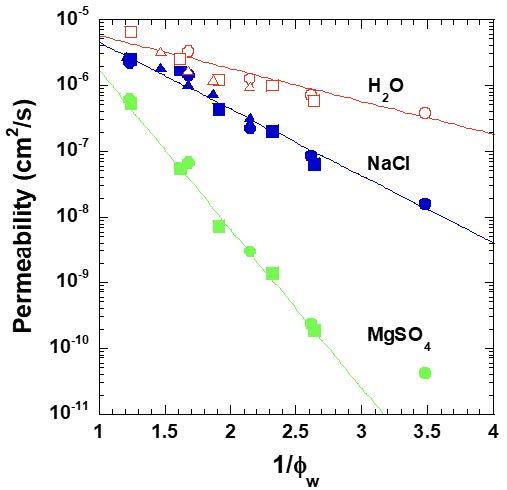
Fig. 3.2. Effect of water volume fraction, vw, on water and salt permeability in model crosslinked PEG polymers.
Research Questions
If one starts with a dry polymer electrolyte/salt system exposed to humid air, where does the first water go (i.e., to a hydration shell around the ion or to plasticizing the polymer?)
How do ion size, density, and chemistry influence this initial hydration?
How does polymer chemistry (local polarity and chemical environment around an ion) influence hydration?
What is the role of hydration on ion pairing/aggregation and ion-membrane (ligand) interactions?
How does one unravel the complexity of water content, ion concentration, and membrane chemistry/functional group binding strength on the process of salt dissolution, ion aggregation, and ion transport?
Research Approach
We propose to bridge the detailed polymer physics understanding already being applied to dry polymer electrolyte systems to the important applications of hydrated membranes. The lack of this fundamental understanding in water purification membranes stymies progress in designing highly permeable and selective membranes for treatment of highly complex water sources in RO or ED or in new applications, such as resource (e.g., Li+) recovery from highly saline brines. Similarly, our lack of knowledge of the impact of water content on pKa values of carboxylic acids in RO membranes limits our ability to predictively design high performance membranes based on these ubiquitous functional groups.
In polymer electrolytes, ion conductivity is achieved through salt dissociation into unpaired cation/anion charge carriers and subsequent transport/diffusion of these ions through the polymer. These two steps strongly depend on several factors, including cation solvation thermodynamics, polymer backbone dynamics that control solvation site connectivity, and the rearrangement of covalently tethered coordination sites (i.e., ligands) with metal cations. As a result, these phenomena and the relationships between ligand bond chemistry and the physics of polymer chains have been widely studied in dry polymer electrolytes aimed at designing highly conductive, selective polymers for energy storage devices. In dry polyelectrolytes, combined Pulsed Field Gradient (PFG)-NMR spectroscopy and electrochemical measurements have demonstrated that ion aggregation and pairing profoundly affect these key metrics of electrolyte performance. The performance of hydrated ion exchange membranes (e.g., crosslinked poly(styrene sulfonate), quaternary ammonium functionalized poly(styrene co-divinyl benzene)), functional groups in RO membranes (e.g., benzoic acid, aniline) that are frequently implemented for water purification can also be strongly affected by ion dissociation (i.e., formation of ion pairs). However, molecular scale understanding and design rules like those employed in the dry polyelectrolyte context have not yet emerged.
We propose to deconvolute the roles of hydration, relative ion size, free volume, and polymer segmental motion on ion conductivity, permeability, and selectivity to yield better future systems, both wet and dry. The hydration shell surrounding an ion affects both its radius and diffusion coefficient as well as the strength of its interaction with membrane ligand groups. Similarly, membrane water content influences both the segmental motion of the chains and the free volume of the system as a whole. In dry polyelectrolyte systems, ion conduction is generally tied directly to polymer segmental motion, so most ion conductivity can be explicitly normalized via Vogel-Tammann-Fulcher (VTF) scaling, but the degree of salt dissolution/ion aggregation is both limited and critical to achieving high conductivities and selectivities.
We hypothesize that small amounts of hydration promote salt dissolution and result in the formation of a hydration shell around the ion of interest, but ion diffusion is controlled by local polymer segmental dynamics. In highly hydrated systems, ion diffusion proceeds through highly hydrated regions of the membrane, with the polymer chains serving as essentially immobile, fixed obstacles that increase tortuosity and reduce the available area for transport240. In both cases, the concept of free volume is often used to rationalize observed trends of ion diffusion coefficients with respect to ion size and membrane water content. Additionally, variations in water content of hydrated membranes strongly influence ion-ligand interactions, causing ion solubility and diffusivity to vary significantly in poorly predicted ways. M-WET’s earlier studies of selective ion transport 12-crown-4 (12C4)-functionalized membranes demonstrated that Li+ ions, which bind selectively to 12C4 groups in nonaqueous media, exhibited little affinity for 12C4 groups in hydrated membranes. Instead, Na+ ions bound strongly with the 12C4 groups, markedly impeding their diffusion and resulting in the highest Li+/Na+ selectivity reported to date for dense, hydrated polymer membranes.
In this GAP, we will leverage both our recent success in developing selective functional groups and the tools used by both the dry and wet polyelectrolyte communities to understand the role of hydration on ion transport and create new design paradigms for ion selective membranes. This effort is divided into two efforts: Project 1 will seek to understand the role of hydration on ion association and develop functional groups that both facilitate ion dissociation/transport as well as selectivity. Project 2 focuses specifically on the role of local polarity on proton and ion affinity and the associated thermodynamic parameters that govern separation, particularly in confined environments.
GAP B, Project 1: Role of Ion-ion and Ion-polymer Interactions on Ion Transport and Separations in Dry to Wet Wystems
In this Project, we will gain understanding of ion hydration and its impact on ion association and provide insight for tuning membrane structures to control water and solute transport. Specifically, we will combine Clément’s pulsed field gradient (PFG)-NMR and novel electrophoretic NMR (eNMR) techniques with electrochemical and mass transport measurements (Freeman, Segalman) and mesoscopic simulations (Ganesan) under controlled hydration, connecting a new molecular level understanding of ion association and hydration with its impact on macroscopic transport in UMCP-derived materials using MFP solutes that are both NMR-active and relevant for water/energy applications (e.g., Li+, K+ Na+, Mg2+, Al3+, PO43-, F-, and TFSI- ions). The novel NMR tools, along with ion aggregation/dissociation analysis previously used by Clement and Segalman in dry polyelectrolyte systems enable the unique determination of ion self-diffusion coefficients and electrophoretic mobilities. These will be merged with macroscopic measures of ion association and ion diffusion typical in water purification systems (Freeman, Katz).
We propose synthesizing a homopolymer model system based on the porous UMCP in which we have tethered ligand groups (Fig. 3.3A). These functionalities range from bulky moieties with delocalized charges based on ionic-liquid chemistries to the denser charges more common in ion exchange membranes. Inclusion of dithiol functional groups allows us to very carefully control crosslink density and therefore the water uptake. Larger charged functional groups lead to weaker electrostatic interactions, but these can be overcome by modest thermal energies such that temperatures at or near room temperature provide substantial ion mobility in dry systems. At UCSB and UT, we have developed a detailed understanding of how segmental motion, ligand-bonding chemistry, backbone dielectric constant, and salt dissolution interplay in dry ion conduction in poly ionic-liquids (PILs). Further, Bates will develop specific interactants to impart ion-size and valency-based selectivity.
We hypothesize that the strength of ligand binding to the solute ions will be influenced by water content and will, in turn, alter both salt dissociation (ion aggregation/pairing) and the dynamics of ion motion. We will probe the role of solute anion and cation identity on the ionic conductivity and selectivity of these dry, decorated membranes in mono- and multivalent salts (LiCl, LiTFSI, NaCl, NaTFSI, KCl, KTFSI, MgCl2, BaCl2, AlCl3) at a range of ion concentrations. Building on the results for dry polymers, we will investigate the role that water plays in these properties by exposing samples to humid air in a quartz crystal microbalance and observing the resultant water uptake and changes in ionic conductivity. We will then, in the IF, correlate these observations with macroscopic changes in ion solubility, permeability, ionic conductivity, and selectivity as a function of water uptake (Katz, Kumar, Freeman). The investigation of alkali cations paired with organic fluorinated anions enables PFG-NMR and eNMR characterization, while also serving as an important bridge between ion dynamics in water filtration and energy focused systems.
Calculation of ion diffusion coefficients from ion permeability and ionic conductivity values using the Nernst-Planck relationship assumes a lack of ion aggregation/pairing. However, ion aggregation (referred to as pairing or clustering in different communities) can be prevalent in such systems and is anticipated to depend sensitively on the extent of membrane hydration, as well as membrane structure, morphology, and ion properties (charge, size, etc.). Yet, our quantitative understanding of the molecular mechanisms that govern ion sorption/transport in water purification membranes is limited to rather crude, continuum level models for highly charged and highly hydrated IEMs that assume complete dissociation, with no systematic connection to less highly charged or neutral polymers. Establishing this connection will require combining the above measurements with non-traditional approaches aimed at establishing a molecular level understanding of ion behavior.
We compare electrochemically measured conductivities, macroscopic ion sorption, and NMR based diffusion measurements to probe the extent of ion aggregation as a function of membrane chemistry and hydration levels. NMR chemical shift analysis of ions in solution will be used to quantify the extent of ion solvation with increasing membrane hydration. We will compliment this analysis with PFG-NMR measurements of anion (𝐷_), cation (𝐷+), and water (𝐷H2O) self diffusion coefficients and eNMR measurements of diffusion under a bias to garner insight into the relationship between membrane hydration and ion/water transport mechanisms. Furthermore, ion self-diffusion measurements will be used to calculate the Nernst-Einstein conductivity, which reflects the average diffusion of all paired and unpaired ions within the membrane (𝜎NE = (INSERT EQUATION) 𝑐i𝐷i, where 𝐹 is Faraday’s constant, R is the molar gas constant, and 𝑧i, 𝑐i, and 𝐷i are the charge, concentration, and ion diffusion coefficients). Together with electrochemical impedance measurements, which account for only charged ionic species, we will quantify the extent of ion aggregation in membranes via the ionicity: 𝐼 = (INSERT EQUATION), where 𝜎EIS. is the conductivity obtained via electrochemical means (cf. Fig. 3.4). Complementing such efforts, atomistic molecular dynamics simulations (Ganesan) will be used to elucidate the mechanistic underpinnings of the experimental observations. Explicitly, the framework of Onsager coefficients will be employed to identify the specific ionic correlations (for e.g., concerted movement of cations and anions) responsible for the ionicity. Such analyses will be combined with other measures such cluster size distribution to elucidate the origins of such dynamical correlations. Such simulations, performed for model metal ions and their counter-ions, will bridge theoretical descriptions of ion diffusion in wet and dry systems (Ganesan), while informing transport dynamics beyond the present macroscopic continuum models. Freeman will complement these efforts with macroscopic membrane measurements (i.e., permeability, ionic conductivity, solubility, diffusivity, and free volume) in the IF.
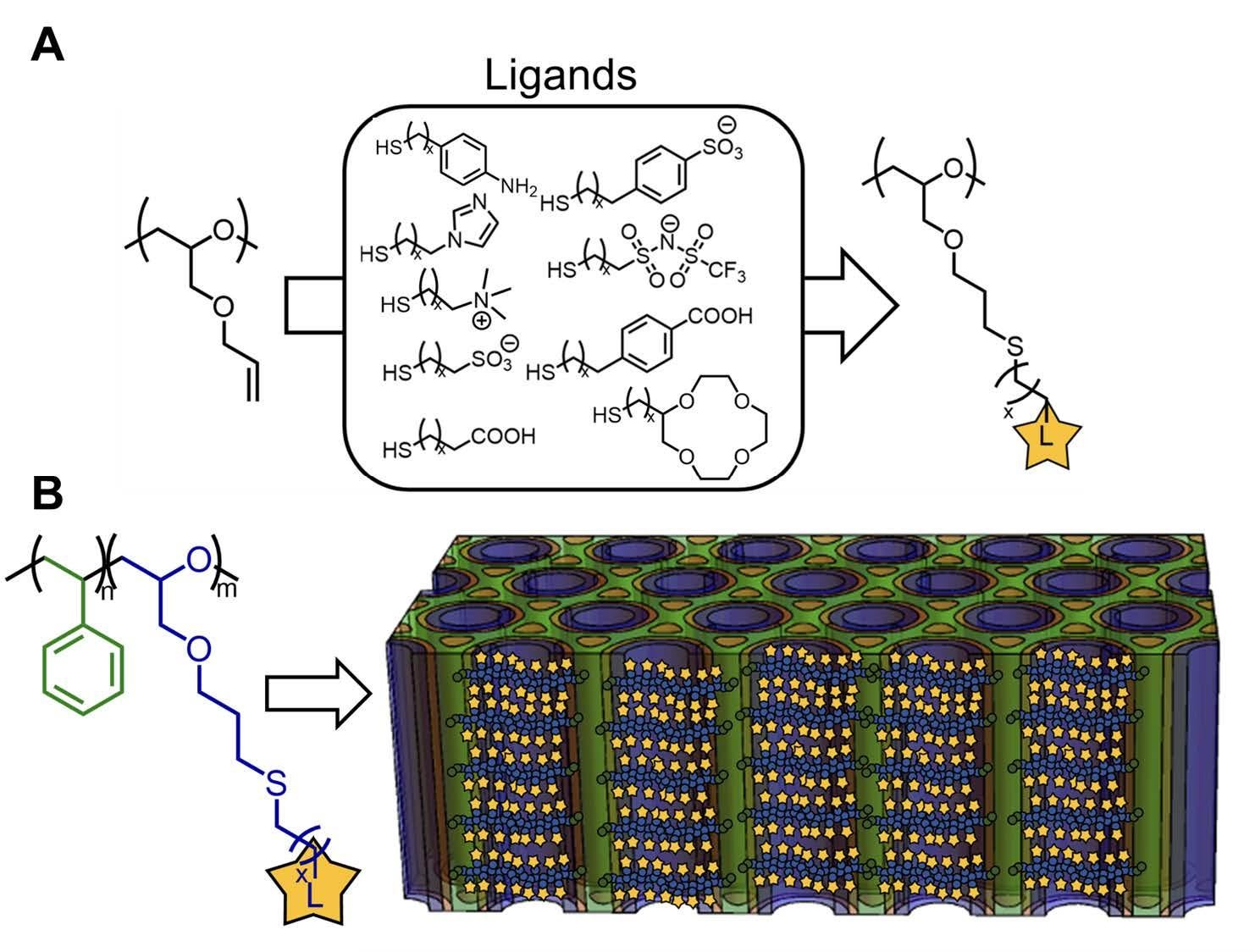
Fig. 3.3. The poly (allyl glycidyl ether) (PAGE) element of the porous UMCP offers a platform for study of multiple ligand (L) chemistries with the same polymer backbone. The polymers will be decorated by efficient Thio-Michael addition chemistry to yield materials with ligands on every monomer. Ligands of particular interest are amine, imidazole, sulfonic acid, carboxylic acid, and TFSI elements shown and will be studied in a homopolymer format in Project 1 (A). This same platform will be leveraged in a block copolymer format (B) such that the role of confinement can be studied in Project 2.
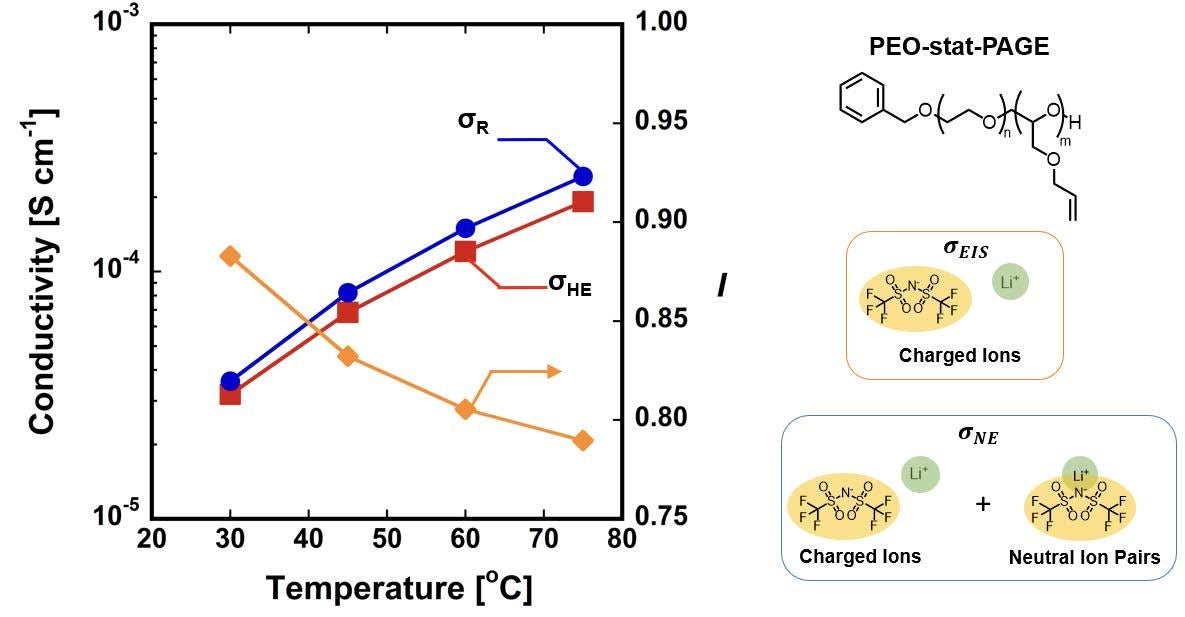
Fig. 3.4. Ion conductivity measured via electrochemical impedance spectroscopy (σEIS) is sensitive to only the presence of charged ions whereas diffusivities measured via PFG-NMR account for both charged ions and neutral ionic pairs/clusters and can be used to reconstruct a conductivity via the Nernst-Einstein equation (σNS). The ionicity, I, (i.e., (σEIS/σNS)) indicates the degree of ion pairing. Here, the ionicity decreases as a function of temperature indicating that ion pairing increases with increasing temperature. We anticipate hydration will have the opposite effect.
GAP B, Project 2: Role of Local Polarity on Ion Association/Aggregarion and Water Interactions
The role of environmental parameters (e.g., confinement, solution composition, and degree of membrane hydration) on ion selectivity (or binding affinity) is often attributed to their impact on the media’s bulk dielectric constant. While continuum level electric field strength changes are incorporated directly into ion activity/sorption models using a dielectric constant (e.g., Manning’s model, Born solvation theory), bulk dielectric constants alone do not capture molecular scale effects on local water/functional group environments responsible for ion and proton binding. For example, some researchers have suggested that local environmental factors (e.g., water content) are responsible for changes in acid dissociation constants (pKa) in membrane networks. Others find no evidence for such changes, which points to missing fundamental science in this area. Using elements of the porous UMCP, we have a unique opportunity to create carefully controlled confined environments for understanding the role of local polarity on proton and ion affinity and the associated thermodynamic parameters that govern separation.
In Project 2 of GAP B, we will use an identical platform of functionalized UMCP elements as Project 1 (Gap B), but now in a self-assembling block copolymer (Fig. 3.3B) with a polystyrene matrix and functionalized/PEO-filled lamellae and cylindrical pores (5-40 nm). Study of solute and solvent transport in functionalized pore interiors will facilitate understanding of local polarity and electrostatic effects in confined systems. In the IF, Katz, Christopher, and Su will study local polarity effects on selectivity and permeability by introducing selected ions and water/alcohol mixtures. Then, using both synchrotron (X-ray absorption spectroscopy to interrogate ion-ligand interactions, and X-ray scattering to monitor changes in block copolymer pore structure) and macroscopic experiments (tritium exchange titrations, ion titrations, confocal microscopy) as well as bulk membrane characterization via the IF, proton and ion sorption and diffusion will be characterized. Varying the water/alcohol concentration provides an alternative approach (i.e., besides changing membrane chemistry) to systematically vary macroscopic dielectric constant, which has been shown to have a strong influence on pKa. In parallel with the above experimental measurements, Henkelman’s MD simulations will track ion dissociation and movement. The use of ML force fields based on DFT data will be key for describing fluctuations in local pKa/pH where variations in local charge environments are important. This approach will allow us to identify the importance of ion-ion interactions and hydration near these charged interfaces and will complement efforts in GAP A to understand the role of surface properties on ion affinities and water structure and dynamics.
Further, the local pH within porous materials containing selected ions and water/alcohol mixtures will be measured using confocal fluorescence microscopy. This approach has proven successful for rapid measurements of local pH in porous materials for applications ranging from corrosion to electrocatalysis. To measure local pH over broad ranges, we will use a combination of pH sensitive dye molecules (LysoSensor green DND-189 (LSG, pH = 1-4), 5(6)-carboxynaphthofluorescein (CNF, pH = 5-8.5), and a ratiometric two-color pH- sensitive fluorescent dye, 6,8-dihydroxy-1,3-pyrenedisulfonic acid (DHPDS, pH = 5-11.5). Measurements of local pH will enable correlations with continuum models and provide measured values for correlation with macroscopic measurements of transport and binding affinity.
The extent of protonation of ionizable groups in polymers can determine the effective fixed charge concentration of the polymer networks. At a given pH, the extent of protonation increases with ligand pKa, simultaneously increasing electrostatic repulsion of mobile ions from the polymer network and increasing water uptake, which enhances ion and water transport in swollen hydrogels (Fig. 3.2 and Fig. 3.5). We hypothesize that the introduction of readily protonated functional groups should increase permeability and selectivity simultaneously. The experiments described above will enable us to test this hypothesis. Moreover, because confinement plays a key role in surface functionalization, hard X-ray and soft/tender resonant X-ray scattering will be used to decipher changes in the pore size and spacing with enhanced contrast between blocks, leveraging recent developments by Su to characterize morphology of hydrated membranes with soft and tender X-rays and correlating these changes to changes in pKa and affinity.
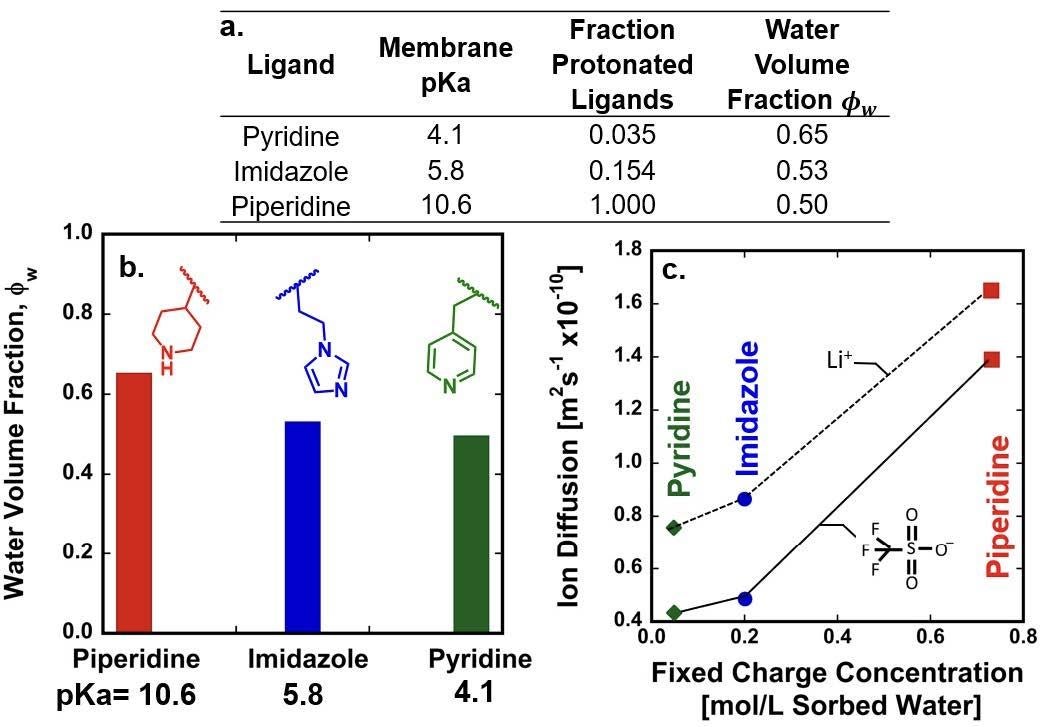
Fig. 3.5. a. Effect of ligand protonation on water content and effective membrane charge density, b. water content is a function of fraction of protonated ligands, c. Ion diffusion is controlled primarily by water content in PEGDA/PEGMEA/acrylate membranes functionalized with ligands of varying Lewis basicity (Fig. 3.3A).
Research Highlights - GAP 2 (M-WET project years 2018 to 2021)
Cation-Ligand Interactions Dictate Salt Partitioning and Diffusivity in Ligand-Functionalized Polymer Membranes
Demonstrated that favorable cation-ligand interactions tend to enhance salt partitioning into 12-Crown-4-functionalized polymer membranes but decrease salt diffusivity.
A Multiscale Simulation Study of Influence of Morphology on Ion Transport in Block Copolymeric Ionic Liquids
Morphology had little influence on the fraction of ions segregating to the interface and the anion mobilities were insensitive to the morphology once the dimensionality of the morphology was accounted for.
Origins of Lithium/Sodium Reverse Permeability Selectivity in 12-Crown-4-Functionalized Polymer Membranes
Elucidated the mechanism of lithium selectivity in 12-Crown-4-functionalized membranes.
Engineering Li/Na Selectivity in 12-Crown-4 Functionalized Membranes (Part 1 of 2)
Reverse LiCl/NaCl selectivity was attained by incorporating 12-crown-4 into a membrane.
Engineering Li/Na Selectivity in 12-Crown-4 Functionalized Membranes (Part 2 of 2)
Reverse LiCl/NaCl selectivity was attained by incorporating 12-crown-4 into a membrane.
Origins of Lithium/Sodium Reverse Permeability Selectivity in 12-Crown-4-Functionalized Polymer Mem.
Elucidated the mechanism of lithium selectivity in 12-Crown-4-functionalized membranes.
Tunable Membrane Platform for Li Ion Recovery
Developed a tunable polymer platform using Ring Opening Metathesis Polymerization (ROMP) into which selective interactants are incorporated.

